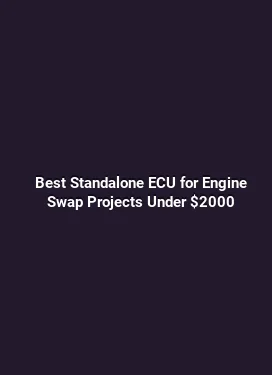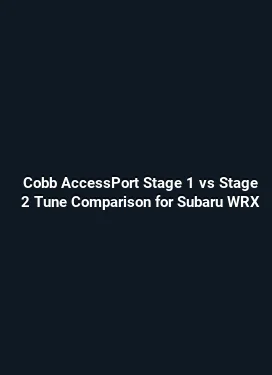Dyno Tuning vs Street Tuning: Which Method is Safer and Better?
Understanding the Core Differences Between Dyno Tuning and Street Tuning

Engine management and calibration approaches have evolved to support a wide range of goals, from push-rod simplicity to modern turbocharged precision. Dyno tuning is a static, controlled process performed on a treadmill-like setup where the vehicle is strapped to rollers and exposed to a range of loads, RPMs, and simulated driving conditions. Street tuning, by contrast, emphasizes real-world operation, adjusting mappings and fueling while the car is driven on actual roads in typical environmental conditions. Each method has its own strengths, trade-offs, and safety considerations that can influence the decision based on the vehicle, the owner's goals, and the level of risk one is willing to accept.
When a tuner approaches a project, the choice often hinges on how much control is needed over critical variables such as air-fuel ratio, ignition timing, boost targets, and transient response. The physical environment, sensor quality, and the vehicle’s baseline health all shape the permissible envelope for tuning. In the following sections, the discussion delves into practical implications, safety considerations, and real-world scenarios that help clarify when dyno-based calibration offers tangible benefits and when street tuning can meet performance ambitions without compromising reliability.
What Dyno Tuning Brings to the Table
Dyno-tuned calibrations are crafted under repeatable conditions, which is invaluable for diagnosing drivability issues and validating performance gains. The process often begins with a baseline run to map the stock behavior, followed by iterative adjustments to fuel delivery, ignition timing, and, for modern engines, boost or wastegate control. The controlled environment minimizes variables such as ambient temperature, humidity, and road load, enabling the tuner to observe precise responses to small changes. This systematic approach helps uncover the true potential of the engine and ensures that improvements are not merely anecdotal.
Key advantages include a thorough evaluation of load-based fueling, closed-loop corrections, and wideband oxygen sensor feedback. By gradually increasing engine load while monitoring AFR (air-fuel ratio) and knock thresholds, the technician can establish a safe operating window and document performance limits. Dyno sessions also support reliability testing, including sustained torque delivery, which is difficult to replicate consistently in street conditions. For engines with forced induction, a dyno setup offers a safe environment to explore boost targets and valve timing strategies without exposing the car to unpredictable street variables.
Practical steps during a typical dyno run

1) Establish a baseline: Capture stock fuel maps, ignition timing, and boost references. 2) Incremental changes: Apply small adjustments to fueling and timing, re-validate at each step. 3) Safety checks: Monitor compressor outlet temperatures, knock events, and exhaust gas temperatures in turbo applications. 4) Data consolidation: Record steady-state and transient responses across a spectrum of RPM and load. 5) Validation: Reproduce the tuned map in real-world driving to compare perceived throttle response and driveability.
What Street Tuning Delivers in Real-World Conditions
Street tuning emphasizes the vehicle’s behavior under typical daily-use scenarios. It accounts for environmental variability, from ambient temperatures to Fuel Quality and driving style. The goal is to deliver a smooth, predictable, and reliable experience across a broad range of conditions. Because street tuning operates in uncontrolled environments, it must be conservative enough to avoid sudden AFR swings, knock, or undesired timing corrections when the engine experiences rapid throttle changes or transient loads. This approach often prioritizes drivability and consistency over peak power, which is a deliberate choice for street cars that must perform reliably under daily use.
One of the main benefits of street tuning is its direct alignment with real-world performance. A calibrated map that passes the daily driving test—city traffic, highway cruising, and occasional spirited accelerations—tends to feel more natural. Tuner teams may rely on on-road data collection to refine trims that minimize throttle lag, maintain stable idle, and reduce fuel trims during cold starts. The result is a tune that behaves predictably, which is highly valued by owners who rely on the car for daily transportation as well as weekend sessions at the track or the strip.
Practical considerations for street tuning
Such tuning often uses portable data logging gear to capture sensor data in real time, including AFR, manifold absolute pressure (MAP), intake air temperature, and ambient conditions. The tuning process emphasizes stability and repeatability, applying lessons learned from the dyno in a more forgiving environment. It is common to perform staged calibrations over several weeks, gradually refining fueling and timing as the car experiences a wider range of daily driving scenarios. Safety margins are built into the map to handle unexpected loads or fuel quality variations without triggering adverse knock or lean excursions.
Safety, Reliability, and Risk Management in Both Approaches
Safety in engine tuning encompasses mechanical integrity, sensor health, and protection against detonation or over-boost. Dyno tuning provides a controlled environment where detonation sensors, knock thresholds, and AFR envelopes can be monitored with precise instrumentation. This reduces the chance of sudden failures and enables faster iteration within safe boundaries. On the other hand, street tuning demands more conservative safeguards because the car operates without the reassurance of a laboratory setting. Tuning strategies for street sessions often incorporate broader safety buffers, conservative timing advance, and ramp limits to reduce the probability of lean misfires or component stress during aggressive acceleration or high-load conditions.
Both methods benefit from robust instrumentation and consistent maintenance. A high-quality wideband oxygen sensor, a reliable boost control system for forced induction, and timely sensor calibrations are essential for accurate feedback. Regular checking of fuel integrity, ignition coils, and wiring ensures that a tuned map remains within the expected boundaries as fuel formulations and temperatures shift with seasons. In this sense, the safety and longevity of the engine are closely tied to the stability of the sensors and the fidelity of the data used to drive calibrations.
Performance Outcomes: How Each Approach Impacts Power, Transients, and Efficiency
Dyno-tuned maps tend to show more aggressive power delivery and refined torque curves because the process is designed to exploit the engine’s potential under peak loads. The measured gains often translate into stronger mid-range torque and a sharper throttle response, especially when boost control and fueling are finely synchronized. However, the peak gains may come with a narrower safe operating window if the baseline components are close to their limits or fuel quality is inconsistent. In contrast, street-tuned calibrations typically emphasize smoothness and consistency, potentially sacrificing top-end peak power for predictable behavior across a broad spectrum of operating conditions. Clients frequently value the improved driveability and lower sensitivity to ambient factors, which translates into better real-world performance and satisfaction in daily use.
Hybrid approaches: leveraging the best of both worlds
Many enthusiasts opt for a hybrid workflow that starts with a dyno-derived baseline map to establish a safe, high-performance envelope, followed by on-road refinements to adapt to real-world variability. This approach combines the reliability of laboratory validation with the practicality of daily driving performance. It is particularly effective for vehicles with advanced engine management systems, variable valve timing, or turbocharged setups where transient behavior is critical. The end result is a map that preserves the stability discovered on the dyno while delivering a refined throttle response and consistent lubrication of fuel trims on the street.
Maintenance, Monitoring, and Long-Term Health of Tuned Engines
Long-term health hinges on proactive monitoring and disciplined maintenance. Post-tuning, owners should establish a routine that includes regular scans for knock events, AFR stability, and sensor health. For turbocharged builds, monitoring exhaust gas temperatures and turbine speeds becomes crucial to prevent overheating and ensure the turbocharger remains within its efficiency range. Fuel system cleanliness, proper filtration, and a consistent grade of fuel also contribute to maintaining the tuning’s integrity. In both dyno and street scenarios, logs and trend data are invaluable for early detection of drift in sensor readings or unexpected shifts in engine behavior. A disciplined maintenance plan ensures that the tuned map remains effective and safe as components age and environmental conditions evolve.
Environmental Considerations and Compliance Aspects
Modern engines are designed to balance performance with emissions and fuel efficiency. Tuning must respect regulatory requirements and avoid strategies that would cause excessive emissions or test failures. Even in a performance-first scenario, a tune should preserve catalytic converter efficiency, maintain stable idle, and avoid excessive fuel enrichment under transient conditions that could trigger rich-catalyst issues. Street calculations often prioritize smooth transitions and predictable engine response to minimize unnecessary fuel use, while dyno-driven work may push the envelope in a controlled manner to verify reliability before real-world application.
Choosing the Right Path for Your Vehicle
The decision between dyno tuning and street tuning depends on the vehicle’s purpose, owner priorities, and risk tolerance. For enthusiasts seeking maximum potential within a known safe operating window and who have access to a reliable dyno facility, dyno tuning offers a rigorous route to quantify gains and validate safety margins. For daily-driven cars or vehicles used in roads with varying conditions, street tuning provides a pragmatic path to stable performance, comfort, and consistency without requiring multiple sessions on a test bench. In some cases, a staged plan that begins with a dyno baseline and ends with careful on-road validation delivers the most balanced outcome, combining measured gains with real-world reliability.
Future Trends in Engine Management and Tuning Practices
Advances in sensor technology, real-time data analytics, and smarter control algorithms are shaping how tuners approach both dyno and street workflows. Enhanced sensor fusion, predictive knock detection, and adaptive learning enable more nuanced control over fueling, timing, and boost deployment. The trend toward modular, scalable calibrations allows for safer experimentation with upgraded hardware while preserving daily driveability. Practically, this means tuners can push the envelope with confidence, leveraging data-driven adjustments and robust validation procedures that translate to tangible improvements in power, responsiveness, and reliability across diverse driving scenarios.
Conclusion Without the Ending: Integrating Knowledge for Informed Decisions
Ultimately, the safer and better approach hinges on clear objectives, disciplined testing, and a commitment to maintenance. Dyno tuning provides a rigorous framework to quantify gains and verify safety in a controlled setting, while street tuning emphasizes stable, predictable behavior in real-world conditions. A thoughtful combination—starting with a data-driven dyno baseline, followed by on-road refinements and continuous monitoring—often yields the most satisfying result for a broad range of enthusiasts and daily drivers. By embracing a methodical workflow, documented data, and prudent safety margins, car owners can elevate performance without compromising reliability or drivability, regardless of the chosen path.






